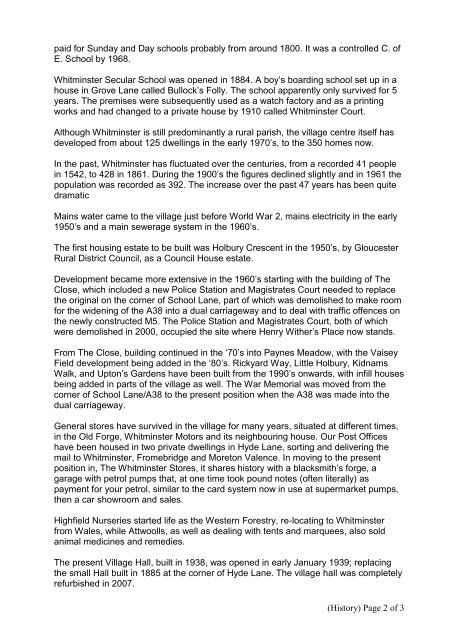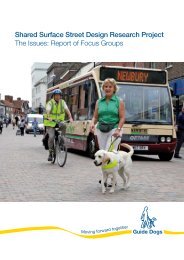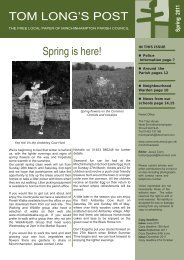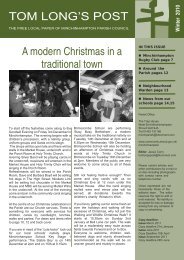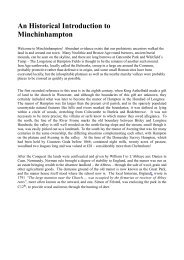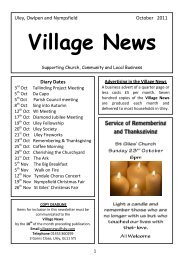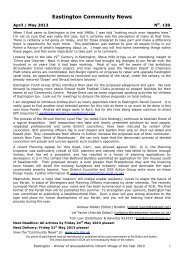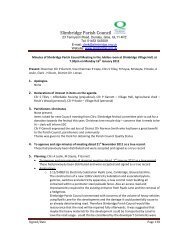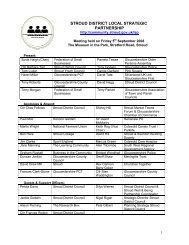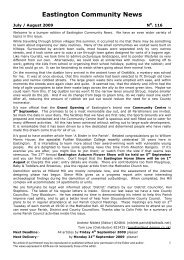Whitminster Parish Plan - Stroud District Community Websites ...
Whitminster Parish Plan - Stroud District Community Websites ...
Whitminster Parish Plan - Stroud District Community Websites ...
Create successful ePaper yourself
Turn your PDF publications into a flip-book with our unique Google optimized e-Paper software.
paid for Sunday and Day schools probably from around 1800. It was a controlled C. of<br />
E. School by 1968.<br />
<strong>Whitminster</strong> Secular School was opened in 1884. A boy‟s boarding school set up in a<br />
house in Grove Lane called Bullock‟s Folly. The school apparently only survived for 5<br />
years. The premises were subsequently used as a watch factory and as a printing<br />
works and had changed to a private house by 1910 called <strong>Whitminster</strong> Court.<br />
Although <strong>Whitminster</strong> is still predominantly a rural parish, the village centre itself has<br />
developed from about 125 dwellings in the early 1970‟s, to the 350 homes now.<br />
In the past, <strong>Whitminster</strong> has fluctuated over the centuries, from a recorded 41 people<br />
in 1542, to 428 in 1861. During the 1900‟s the figures declined slightly and in 1961 the<br />
population was recorded as 392. The increase over the past 47 years has been quite<br />
dramatic<br />
Mains water came to the village just before World War 2, mains electricity in the early<br />
1950‟s and a main sewerage system in the 1960‟s.<br />
The first housing estate to be built was Holbury Crescent in the 1950‟s, by Gloucester<br />
Rural <strong>District</strong> Council, as a Council House estate.<br />
Development became more extensive in the 1960‟s starting with the building of The<br />
Close, which included a new Police Station and Magistrates Court needed to replace<br />
the original on the corner of School Lane, part of which was demolished to make room<br />
for the widening of the A38 into a dual carriageway and to deal with traffic offences on<br />
the newly constructed M5. The Police Station and Magistrates Court, both of which<br />
were demolished in 2000, occupied the site where Henry Wither‟s Place now stands.<br />
From The Close, building continued in the „70‟s into Paynes Meadow, with the Vaisey<br />
Field development being added in the „80‟s. Rickyard Way, Little Holbury, Kidnams<br />
Walk, and Upton‟s Gardens have been built from the 1990‟s onwards, with infill houses<br />
being added in parts of the village as well. The War Memorial was moved from the<br />
corner of School Lane/A38 to the present position when the A38 was made into the<br />
dual carriageway.<br />
General stores have survived in the village for many years, situated at different times,<br />
in the Old Forge, <strong>Whitminster</strong> Motors and its neighbouring house. Our Post Offices<br />
have been housed in two private dwellings in Hyde Lane, sorting and delivering the<br />
mail to <strong>Whitminster</strong>, Fromebridge and Moreton Valence. In moving to the present<br />
position in, The <strong>Whitminster</strong> Stores, it shares history with a blacksmith‟s forge, a<br />
garage with petrol pumps that, at one time took pound notes (often literally) as<br />
payment for your petrol, similar to the card system now in use at supermarket pumps,<br />
then a car showroom and sales.<br />
Highfield Nurseries started life as the Western Forestry, re-locating to <strong>Whitminster</strong><br />
from Wales, while Attwoolls, as well as dealing with tents and marquees, also sold<br />
animal medicines and remedies.<br />
The present Village Hall, built in 1938, was opened in early January 1939; replacing<br />
the small Hall built in 1885 at the corner of Hyde Lane. The village hall was completely<br />
refurbished in 2007.<br />
(History) Page 2 of 3


